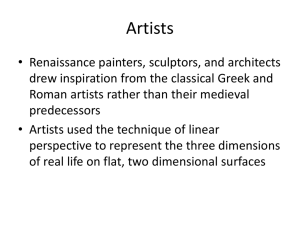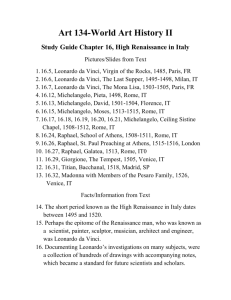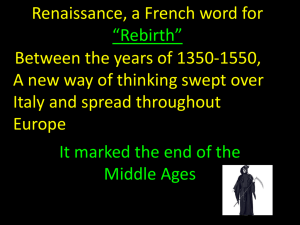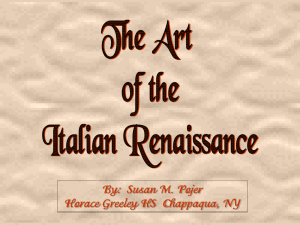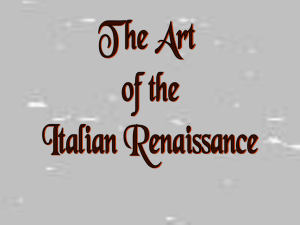renaissance is a french word…it means “rebirth”
advertisement
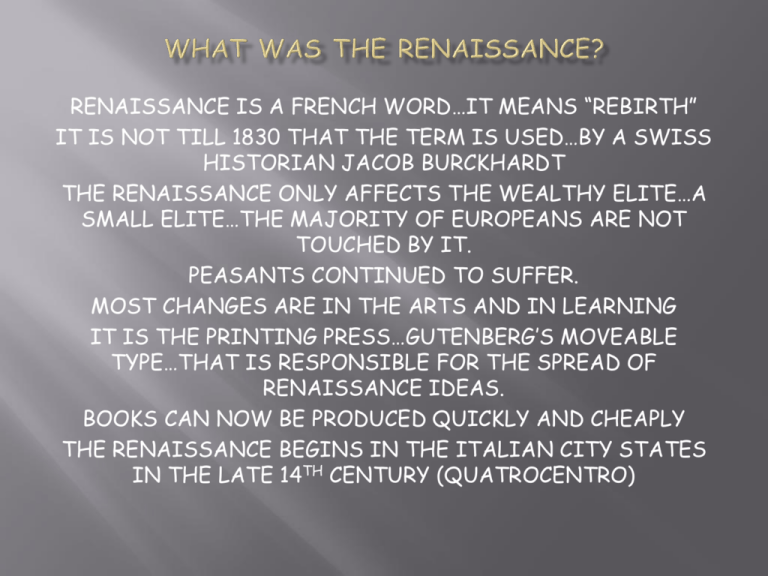
RENAISSANCE IS A FRENCH WORD…IT MEANS “REBIRTH” IT IS NOT TILL 1830 THAT THE TERM IS USED…BY A SWISS HISTORIAN JACOB BURCKHARDT THE RENAISSANCE ONLY AFFECTS THE WEALTHY ELITE…A SMALL ELITE…THE MAJORITY OF EUROPEANS ARE NOT TOUCHED BY IT. PEASANTS CONTINUED TO SUFFER. MOST CHANGES ARE IN THE ARTS AND IN LEARNING IT IS THE PRINTING PRESS…GUTENBERG’S MOVEABLE TYPE…THAT IS RESPONSIBLE FOR THE SPREAD OF RENAISSANCE IDEAS. BOOKS CAN NOW BE PRODUCED QUICKLY AND CHEAPLY THE RENAISSANCE BEGINS IN THE ITALIAN CITY STATES IN THE LATE 14TH CENTURY (QUATROCENTRO) WEALTH…SPURS ON THE RENAISSANCE…AND LOTS OF IT! ITALY IS BEAUTIFULLY POSITIONED BETWEEN THE MUSLIM EAST AND THE CHRISTIAN NORTH. ITALY TRADES THE SPICES PRODUCED IN THE EAST TO THE CHRISTIAN NORTH…THEY ACT AS GO BETWEENS. CHRISTIANS DO NOT WANT TO DEAL WITH MUSLIMS SPICE…SUCH AS PEPPER, GINGER, CURRY, CINNAMON, ETC…WAS OUNCE FOR OUNCE MORE VALUABLE THAN GOLD THEY INVENT BANKS OF COURSE!!! THEY HAVE SO MUCH MONEY THEY START LENDING IT TO PEOPLE ALL OVER EUROPE…NO NOT TO PEASANTS! THEY CHARGE INTEREST AND MAKE EVEN MORE MONEY! THE MORE MONEY THAT CAME IN TO THEM…THE MORE LUXURIES THEY BOUGHT, THE MORE LUXURIES THEY HAD, THE MORE THEY WANTED…SOUND FAMILIAR…WHO HAS AN iphone? THEY ALSO HAD LEISURE TIME TO PURSUE NEW IDEAS…LIKE HUMANISM (WE WILL GET TO IT)… AND PATRONAGE OF THE ARTS…THEY COMMISSIONED ARTISTS TO PAINT FOR THEM…UHH LEONARDO WILL YOU PAINT MY PORTRAIT…? Miss Italy…runner up It’s the donuts on my ears isn’t it? PORTRAITS ANYONE? I’m so pretty… Miss Italy, 1560 Life in Europe, in the Middle Ages was miserable. The Middle Ages was a time when RELIGION was the dominant feature…life was a preparation for the afterlife….to gain Salvation. MAN WAS POWERLESS IN A HARSH UNIVERSE…WE COULD NOT CHANGE THINGS, WE HAD TO JUST ACCEPT…SUFFERING WAS PART OF OUR LOT IN LIFE. The church would explain the WHY in terms of religion…you were not pious enough, you had displeased God, you had not given enough money to the church…It changed to…Life can be lived for today, and yes, it can be enjoyed. We go from spiritual reward to material reward. THE CHURCH WAS NOT HAPPY!!! From the SPIRITUAL TO THE SECULAR -- The secular emphasizes the “here and now” rather than the “other world of heaven” Emphasis is placed on material rewards rather than on spiritual happiness. The world begins to be explained in terms of DISCOVERABLE CAUSES…The Bible is superseded as the ultimate authority Secularism changed the attitude of helplessness Checkout the following Shakespeare quote from Hamlet… “WHAT A PIECE OF WORK IS MAN, HOW NOBLE IN REASON, HOW INFINITE IN FACULTY, IN FORM AND MOVING, HOW EXPRESS AND ADMIRABLE IN ACTION, HOW LIKE AN ANGEL IN APPREHENSION, HOW LIKE A GOD: THE BEAUTY OF THE WORLD, PARAGON OF ANIMALS” Contrast Shakespeare's attitude with that of the Middle Ages… TYPICAL DRESS FOR RENAISSANCE LADIES THE MONA LISA You knew that The Renaissance “Man”…the ideal man was knowledgeable about many things in different fields…a man of Virtu excelling in all he did He was confident in himself…in his abilities He made the most of his opportunities A deep knowledge of literature, poetry, rhetoric, business, the art of war, self-defense, he spoke 2 or 3 languages…and of course he was a man of INTEGRITY and DIGNITY He was able to link information from different areas and disciplines to create new knowledge. He was a HUMANIST…(next slide) The Greek ideal of the “well-rounded man” was at the heart of Renaissance education. DIGNITY CONFIDENCE INTEGRITY OPPORTUNITIES LITERATURE SELF DEFENCE There are different interpretations of what HUMANISM was.. It is primarily a way of seeing the world around you and interacting with that world…a “moral compass” PETRARCH (1304-1374)is considered to be the “Father of Humanism”…he is anti-war and pro-secular literature. Humanist goals were: a) demonstrate a knowledge of languages…Latin, Greek, Hebrew, and a modern vernacular b) Know history…especially Ancient Greek and Roman c) Be athletic…the manly art of fencing d) Moral character…getting away from the church’s view of “God’s will” humanists believed in FREE WILL. e) Behavior…manners and courtesy…how you act towards people…best seen in Baldasar Castiglione’s The Courtier which was a manual of how to act, how to court and make love… f) You applied these humanist philosophies to cultural and political life…you contributed to your communities with beautification projects like sculpture and public artworks MEDIEVAL ART DEALT WITH RELIGIOUS THEMES…BIBLICAL STORIES RENAISSANCE ART DID HAVE RELIGIOUS THEMES BUT OFTEN DEALT WITH SECULAR THEMES…PORTRAIT, NUDES (COVER YOUR EYES WE ARE IN VISTA!) ARTISTS BEGIN TO USE OIL PAINTS AS A MEDIUM LINEAR PERSPECTIVE GIVES THE IMPRESSION OF THREE DIMENSIONALITY ART OBSERVES THE NATURAL WORLD AND HUMAN EMOTION SCULPTURE…EXPLORES INDIVIDUALISTIC, NON-RELIGIOUS, NUDES ARCHITECTURE…LOOKED BACK TO THE ANCIENT GREEKS AND ROMANS…ROUNDED ARCHES AND SQUARED ANGLES LITERATURE…BECAME MORE SECULAR. AUTHORS EXPLORED THE HUMAN CONDITION…e.g. SHAKESPEARE, CASTIGLIONE, BOCCACCIO, AND MACHIAVELLI…write down the books these authors wrote and what were the books about. From Medieval art To Renaissance art Realism & Expression Expulsion from the Garden Masaccio 1427 First nudes since classical times. Linear Perspective The Trinity Perspective! Perspective! Perspective! Perspective! Perspective! Masaccio 1427 Perspective! Perspective! First use of linear perspective! What you are, I once was; what I am, you will become. Classicism Greco-Roman influence. Secularism. Humanism. Individualism free standing figures. Symmetry/Balance The “Classical Pose” Medici “Venus” (Greek 1st century) Emphasis on Individualism Batista Sforza & Federico de Montefeltre: The Duke & Dutchess of Urbino Piero della Francesca, 1465-1466. Do I have a bump on my nose? Isabella d’Este – da Vinci, 1499 1474-1539 “First Lady of the Italian Renaissance.” Great patroness of the arts in Mantua. Known during her time as “First Lady of the World!” Geometrical Arrangement of Figures The Dreyfus Madonna with the Pomegranate Leonardo da Vinci 1469 The figure as architecture! Light & Shadowing/Softening Edges Sfumato Chiaroscuro Florence Under the Medici The Medici Chapel The Medici Palace Lorenzo the Magnificent 1478 - 1521 Cosimo de Medici 1517 - 1574 Commissioned to build the cathedral dome. Used unique architectural concepts. He studied the ancient Pantheon in Rome. When he designed the dome for the cathedral in Florence he… Used ribs for support. Brunelleschi’s “Secret” Brunelleschi’s Dome Dome Comparisons Il Duomo (Florence) St. Peter’s St. Paul’s (Rome) (London) US Capital (Washington) Let us now take a look at some examples of how the individual was portrayed during the Renaissance Self-Portrait -- da Vinci, 1512 Artist Sculptor Architect Scientist Engineer Inventor 1452 - 1519 This diagram is taken from an illustration of Vitruvius' theory by Leonardo da Vinci The L’uomo universale Vitruvius, the architect, says in his work on architecture that the measurements of the human body are as follows: 4 fingers make 1 palm; 4 palms make 1 foot; 6 palms make 1 cubit; 4 cubits make a man's height. 4 cubits make one pace and 24 palms make a man. The length of a man's outspread arms is equal to his height. “From the roots of his hair to the bottom of his chin is a tenth of a man's height; from the bottom of the chin to the top of the head is one eighth of his height; from the top of the breast to the roots of the hair will be the seventh part of the whole man. From the nipples to the top of the head will be the fourth part of man. The greatest width of the shoulders contains in itself the fourth part of man. From the elbow to the tip of the hand will be the fifth part of a man; and from the elbow to the angle of the armpit will be the eighth part of man. Leonardo, the artist: from his notebook…of over 5000 pages No stylized beauty here…the individual in all his/her ugliness Mona Lisa – da Vinci Mona Lisa OR da Vinci?? Leonardo, the Artist The Virgin of the Rocks Leonardo da Vinci 1483-1486 The Refractory at the Convent of Santa Maria delle Grazie in Milan The Last Supper by Leonardo da Vinci, 1498 A lesson in Geometry vertical The Last Supper - da Vinci, 1498 horizontal Multiple Perspectives! A Da Vinci “Code”: Is it John, or, is it Mary Magdalene? Deterioration of the masterpiece.. Closeup of Jesus The Last Supper Leonardo da Vinci 1498 Let us move on to other artists and sculptors of the Renaissance The Liberation of Sculpture David by Donatello 1430 First free-form bronze since Roman times! Another David by Verrocchio 1473 - 1475 A third example of David by Michelangelo Buonarotti 1504 made from Marble 15th century What a difference a century makes! 16th century Comparing Domes The Sistine Chapel Michelangelo Buonarroti 1508 - 1512 The Sistine Chapel’s Ceiling Michelangelo Buonarroti 1508 - 1512 The Sistine Chapel …one of the panels The Creation of the Heavens The Sistine Chapel… more Creation of Man Details The Sistine Chapel …More Details Adam and Eve… The Fall from Grace The Sistine Chapel …More Details The Last Judgment The Popes as Patrons of the Arts The Pieta Michelangelo Buonarroti 1499 marble Michelangelo's Moses This is the last of Michelangelo's projects for the tomb which Pope Julius commissioned in 1506. The statue of Moses was sculpted during the years when Michelangelo was painting the Sistine Chapel. You see Moses glaring at the children of Israel after he descends from Mt. Sinai with the Tablets of the Law…the 10 commandments…Thou shalt listen to Mr. Green!!! The extraordinary force of this figure, the tension in the veins and muscles, the posture and the furious expression, have rightly made this Moses one of the most admired masterpieces of all time. Please notice the HORNS atop Moses head! Rafael (1483-1520) Self-Portrait, 1506 Portrait of the Artist with a Friend, 1518 Baldassare Castiglione by Raphael, Castiglione represented the humanist “gentleman”… a man of refinement and self-control. In The Courtier …a manual of manners and courtly love…he describes the ideal man Perspective! Betrothal of the Virgin Raphael 1504 Raphael’s Canagiani Madonna, 1507 Raphael’s Madonnas Sistine Madonna Cowpepper Madonna More of Raphael’s Madonnas Madonna della Sedia Alba Madonna The School of Athens – Raphael, 1510 -11 Da Vinci Raphael Michelangelo The School of Athens – Raphael, details Plato: looks to the heavens… or the IDEAL realm. Aristotle: looks to this earth…the here and now. Hypatia Pythagoras Zoroaster Ptolemy Euclid The School of Athens – Raphael, 1510 -11 One point perspective. All of the important Greek philosophers and thinkers are included all of the great personalities of the Seven Liberal Arts! A great variety of poses. Located in the papal apartments library. Raphael worked on this commission simultaneously as Michelangelo was doing the Sistine Chapel. No Christian themes here. http://www.wga.hu/index1.html A great resource for your art project

